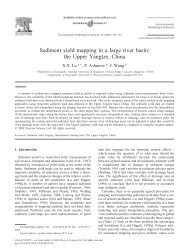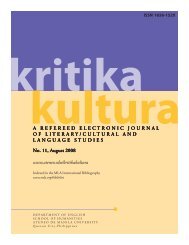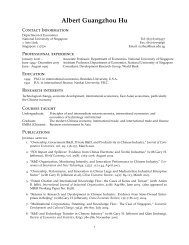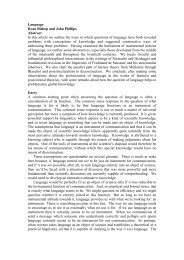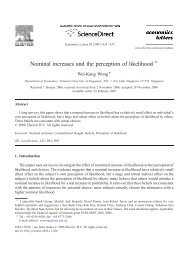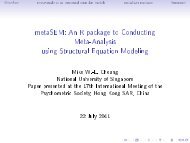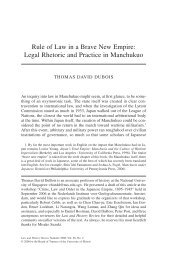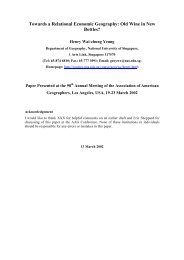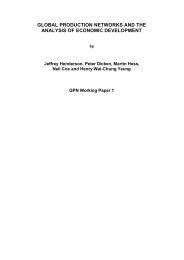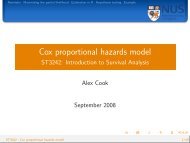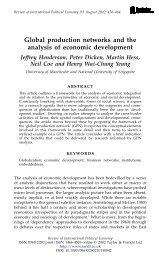The aggregate consumption puzzle in Singapore
The aggregate consumption puzzle in Singapore
The aggregate consumption puzzle in Singapore
Create successful ePaper yourself
Turn your PDF publications into a flip-book with our unique Google optimized e-Paper software.
572 T. Abeys<strong>in</strong>ghe, K.M. Choy / Journal of Asian Economics 15 (2004) 563–578<br />
confirmed by our regression results). For this reason, we have crossed the l<strong>in</strong>k from these<br />
assets to <strong>consumption</strong> <strong>in</strong> Fig. 4.<br />
Unlike <strong>in</strong> bigger countries, there are no cheap suburbs <strong>in</strong> S<strong>in</strong>gapore where one could buy<br />
a similar or better house and enjoy the capital ga<strong>in</strong>s from the sale of the exist<strong>in</strong>g one. <strong>The</strong><br />
sole option available to S<strong>in</strong>gaporeans, apart from emigration to other countries, is to<br />
downgrade to a smaller unit. Direct downgrad<strong>in</strong>g from private hous<strong>in</strong>g to HDB apartments<br />
appears to be uncommon because of psychological resistance and a segmented hous<strong>in</strong>g<br />
market, especially <strong>in</strong> terms of the amenities provided by private estates. However,<br />
downgrad<strong>in</strong>g takes place <strong>in</strong> a more subtle way. <strong>The</strong> fact that about 85% of elderly parents<br />
live with their children suggests that parents might move <strong>in</strong>to a smaller flat with their<br />
children <strong>in</strong> their old age. In this case, the parental house or the proceeds from its sale are<br />
passed on to their descendants <strong>in</strong> the form of bequests.<br />
As house prices go up, the <strong>in</strong>crease <strong>in</strong> the value of hous<strong>in</strong>g assets is accompanied by a<br />
concurrent rise <strong>in</strong> the f<strong>in</strong>ancial liabilities of households, <strong>in</strong> the form of higher down<br />
payments for the purchase of residential properties and burgeon<strong>in</strong>g hous<strong>in</strong>g loans. Due to<br />
the limited avenues for liquidat<strong>in</strong>g house assets, households have to build up sufficient<br />
f<strong>in</strong>ancial assets to smooth the profiles of their lifetime <strong>consumption</strong> of non-hous<strong>in</strong>g goods<br />
and services. In Fig. 4, the dotted arrow from hous<strong>in</strong>g loans to f<strong>in</strong>ancial assets shows this<br />
<strong>in</strong>direct l<strong>in</strong>k. While an <strong>in</strong>crease <strong>in</strong> household f<strong>in</strong>ancial wealth is likely to have a positive<br />
impact on <strong>consumption</strong>, part of the build-up <strong>in</strong> f<strong>in</strong>ancial assets occurs because of the<br />
illiquid nature of house assets. <strong>The</strong> implication is that, as house prices rise over time <strong>in</strong><br />
S<strong>in</strong>gapore, the <strong>consumption</strong> profiles chosen by later generations of households do not<br />
<strong>in</strong>crease as fast as their <strong>in</strong>come. <strong>The</strong>refore, one has to control for this effect <strong>in</strong> a regression<br />
to avoid the problem of omitted variable bias.<br />
<strong>The</strong> negative effect on <strong>consumption</strong> of an <strong>in</strong>crease <strong>in</strong> house prices work<strong>in</strong>g through the<br />
loans channel is also <strong>in</strong>dicated <strong>in</strong> Fig. 4. <strong>The</strong>re is some empirical evidence for this direct<br />
l<strong>in</strong>k: Phang (2004) found that anticipated house price <strong>in</strong>creases have a dampen<strong>in</strong>g effect on<br />
<strong>aggregate</strong> <strong>consumption</strong> <strong>in</strong> S<strong>in</strong>gapore, although the impact is statistically <strong>in</strong>significant. She<br />
attributes the f<strong>in</strong>d<strong>in</strong>g to what she called the ‘‘negative wealth effect’’ of price <strong>in</strong>creases on<br />
those seek<strong>in</strong>g to enter the hous<strong>in</strong>g market or to upgrade to better hous<strong>in</strong>g (Ludwig & Sløk,<br />
2002 refer to this as a ‘‘substitution effect’’). S<strong>in</strong>ce both wealth and substitution effects<br />
have to be non-negative for a normal good and for lack of a better name, we call the<br />
negative impact of a rise <strong>in</strong> house prices the ‘‘price effect.’’<br />
<strong>The</strong> price effect is likely to be well captured by a loans variable. Unfortunately, a time<br />
series on hous<strong>in</strong>g loans is not available <strong>in</strong> S<strong>in</strong>gapore. A composite variable made up of<br />
loans for build<strong>in</strong>gs, construction, and hous<strong>in</strong>g was found to be less appropriate. <strong>The</strong> best<br />
proxy for hous<strong>in</strong>g loans we can f<strong>in</strong>d is withdrawals from the CPF to f<strong>in</strong>ance the purchases<br />
of houses and mortgages. 8 To capture other loans, <strong>in</strong>clud<strong>in</strong>g car loans, we used data on<br />
bank lend<strong>in</strong>g to professional and private <strong>in</strong>dividuals. <strong>The</strong>se two loan variables, after<br />
deflat<strong>in</strong>g by the CPI, are found <strong>in</strong> prelim<strong>in</strong>ary <strong>in</strong>vestigations to have negative effects on<br />
8 Withdrawals from the CPF to pay for publicly built flats have been allowed s<strong>in</strong>ce 1968; <strong>in</strong> 1981, the rules<br />
were liberalized to cover private residential properties. <strong>The</strong> <strong>in</strong>crease <strong>in</strong> such withdrawals have been particularly<br />
rapid s<strong>in</strong>ce the early 1980s, hav<strong>in</strong>g grown from 2.8% of disposable <strong>in</strong>come <strong>in</strong> 1977 to 6.4% by 2000; as a<br />
proportion of CPF contributions, they have averaged about 40% dur<strong>in</strong>g the 1990s.



